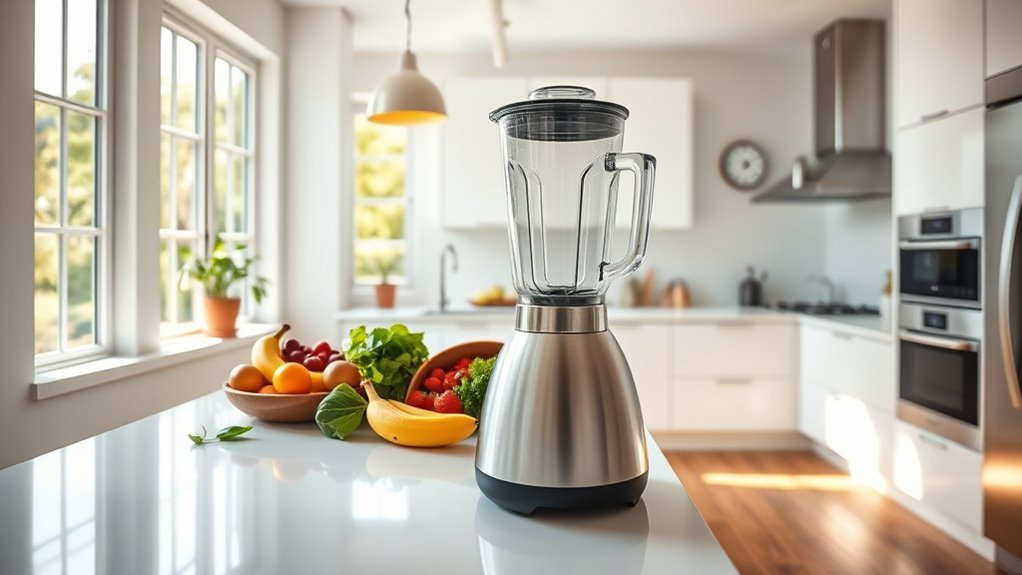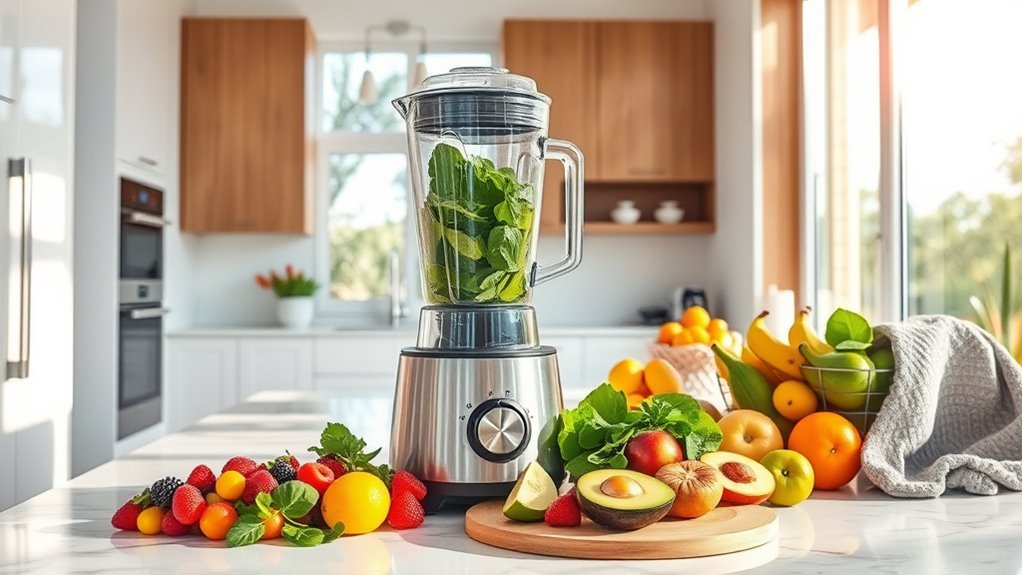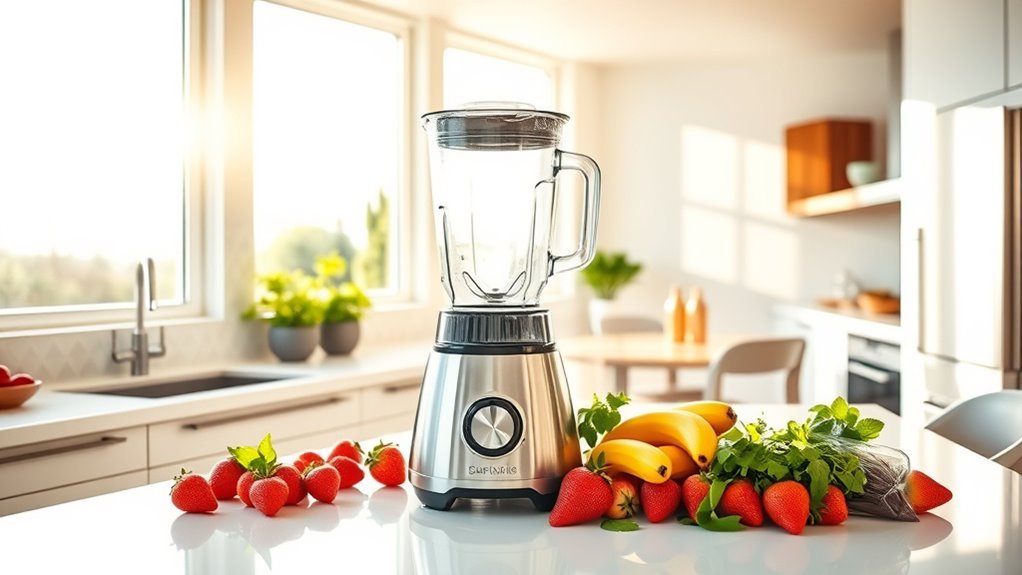We’ll help you keep your mixer pristine with these battle-tested tips. Clean components immediately with mild dish soap (skip antibacterial varieties), and dry thoroughly – moisture is the enemy. Store attachments in dry spots, never under sinks. Monthly food-grade oil lubrication on moving parts prevents wear. Attack early rust signs with baking soda-vinegar paste. Follow our maintenance playbook, and your mixer will stay rust-free for decades.
Daily Cleaning Practices to Prevent Oxidation

Four essential daily cleaning practices will keep your mixer’s components oxidation-free and pristine.
Let’s prevent rust before it starts. After each use, we’ll wash the stainless steel bowl and attachments immediately with warm, soapy water – but not just any soap.
Skip those fancy antibacterial formulas with halogen salts or Triclosan; they’re rust magnets in disguise.
Next, we’ll dry everything thoroughly with a clean dish towel. No exceptions, no shortcuts. Moisture is the enemy here.
Store those attachments in a dry spot – forget that under-sink cabinet with its steamy environment.
If rust dares to appear, we’ve got a secret weapon: baking soda and vinegar paste. Apply it, let it sit, then scrub that oxidation into oblivion.
Proper Drying and Storage Methods
While we’ve covered the cleaning basics, proper drying and storage make the difference between a mixer that lasts decades and one that dies young. Make sure to clean your bowl and uncoated attachments thoroughly, then dry them with a soft cloth immediately. Never stack them wet – that’s asking for trouble.
| Component | Drying Method | Storage Solution |
|---|---|---|
| Bowl | Soft cloth | Inverted on stand |
| Whisk | Hand dry | Hanging rack |
| Paddle | Air dry | Drawer divider |
| Dough Hook | Thorough wipe | Moisture-free bin |
We recommend using a cover to prevent moisture and dust accumulation. Don’t just toss attachments in a drawer – they’ll scratch and rust faster than you can say “baking disaster.” Instead, store them separately in a dry place, and inspect regularly for early signs of oxidation.
Essential Lubrication Techniques

Just as your car needs regular oil changes, your mixer requires proper lubrication to keep running smoothly.
We’ll show you how to prevent rust formation and maintain peak performance through proper maintenance.
Monthly, lubricate your mixer’s planetary shaft and bowl rails with food-grade oils.
Don’t overdo it – a light coating is all you need. Excess oil attracts dust and creates more problems than it solves.
Before applying lubricant, verify all lubrication points are clean and dry. Trapped moisture is your enemy here.
Keep an eagle eye on those vital spots. If you notice any early signs of rust or wear, address them immediately.
Trust us on this – prevention beats repair every time. A well-lubricated mixer isn’t just smoother; it’ll serve you faithfully for years to come.
Removing Early Signs of Rust
Even with proper lubrication, rust can sneak up on your mixer’s components. Let’s tackle those early signs before they become major problems. We’ll show you how to spot and eliminate rust while protecting your investment.
| Problem Area | Warning Signs | Quick Fix |
|---|---|---|
| Stainless Steel Bowl | Brown spots | Baking soda + vinegar paste |
| Metal Attachments | Orange discoloration | Immediate cleaning |
| Connection Points | Dark patches | Thorough drying |
| Storage Areas | Moisture buildup | Use protective covers |
For stainless steel components, we recommend our tried-and-true rust removal method: Create a paste with baking soda and vinegar, apply to affected areas, let it sit, then scrub thoroughly. Always dry completely after cleaning, and avoid harsh detergents containing halogen salts or bleach. Store attachments in a dry place – moisture is rust’s best friend.
Best Cleaning Products and Solutions

When it comes to cleaning your mixer, the right products make all the difference. Your KitchenAid Stand Mixer deserves proper care with cleaning products that prevent rust while maintaining its pristine condition.
We’ve found that mild dish soap, particularly blue Dawn®, works wonders on stainless steel components without risking damage or corrosion.
- Skip harsh cleaners containing halogen salts or bleach – they’re rust magnets
- Use a baking soda-vinegar paste for stubborn spots that won’t budge
- Keep a dedicated cleaning kit with soft cloths and mild dish soap
- Always dry thoroughly after cleaning – moisture is the enemy
Regular Maintenance Schedule
Now that you’ve got the right cleaning supplies, let’s get you on a proper maintenance schedule that’ll keep your mixer running like new.
We’re establishing a no-nonsense cleaning routine: wash components immediately after each use – no exceptions.
Monthly, we’ll lubricate the planetary shaft and bowl rails with food-grade oil. It’s non-negotiable for preventing rust development.
Inspect your stainless steel mixing bowl weekly for any corrosion signs, and adjust your cleaning methods if you spot issues.
And don’t forget those attachments – check them for cracks during regular maintenance.
Your mixer’s exterior needs attention too.
We’re targeting those sneaky spots where moisture and grease love to hide.
Trust us – this systematic approach to maintenance will save you from costly repairs down the line.
Handling Moisture and Humidity Control
Since moisture is your mixer’s worst enemy, let’s get aggressive about humidity control. Your KitchenAid Mixer needs protection from moisture accumulation, which can silently trigger rust formation.
We’re talking about a battle against invisible water molecules that love to settle in your mixing bowl and attachments.
- Place a dehumidifier near your mixer’s storage area to maintain ideal humidity control
- Immediately wipe down every surface after washing, including those sneaky spots under attachments
- Skip harsh soaps containing halogen salts or bleach – they’re rust formation catalysts
- Store attachments in a moisture-proof container with silica gel packets
Don’t let humidity win this fight. A properly dried and stored mixer can last generations, while a neglected one might rust before its time.
Frequently Asked Questions
Are You Supposed to Grease a Kitchenaid Mixer?
We don’t need to grease our KitchenAid mixers as they come with sealed lubrication systems. Regular use helps distribute existing grease, but professional servicing may be needed after extensive wear.
How to Remove Oxidation From Kitchenaid?
Tired of unsightly oxidation? Let’s boil our KitchenAid attachments in vinegar and water for 20 minutes, then gently wipe with a soft cloth. Regular cleaning and dry storage prevent future rust.
How to Maintain a Dough Mixer?
We’ll keep our dough mixer running smoothly by cleaning attachments with soapy water, storing in dry areas, checking for corrosion regularly, and lubricating moving parts monthly with food-grade oil.
Why Is My Kitchenaid Mixer Turning Dough GREY?
We’ve all been there – grey dough looking like concrete! It’s happening because your mixer’s metal attachments are oxidizing when they meet acidic ingredients, while poor mixer maintenance lets metal alloys react during mixing techniques.

